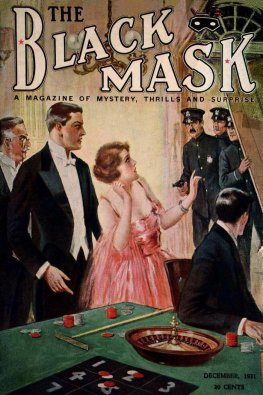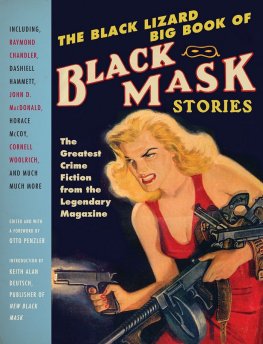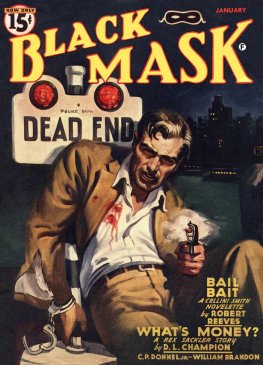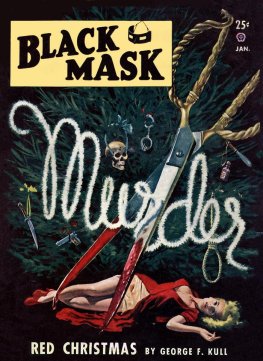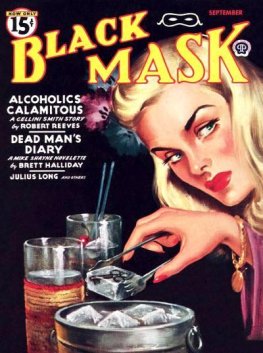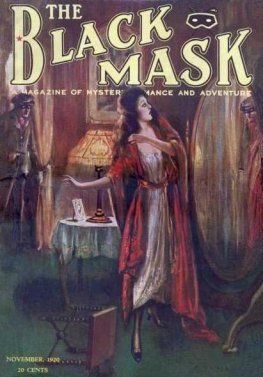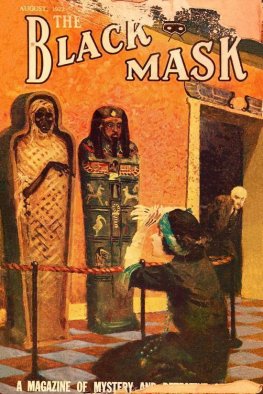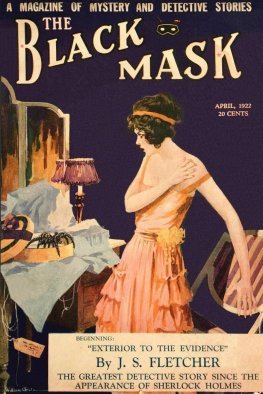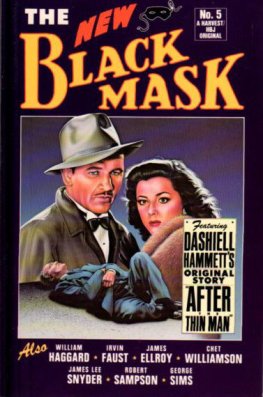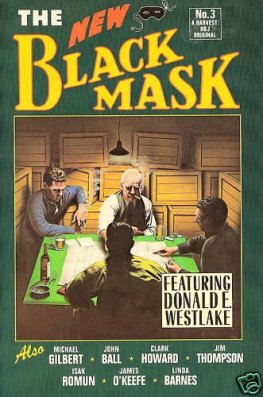Meredith Beyers - The Black Mask Magazine (Vol. 4, No. 3 — December 1921)
Here you can read online Meredith Beyers - The Black Mask Magazine (Vol. 4, No. 3 — December 1921) full text of the book (entire story) in english for free. Download pdf and epub, get meaning, cover and reviews about this ebook. City: New York, year: 1921, publisher: Pro-distributors Publishing Company, genre: Detective and thriller. Description of the work, (preface) as well as reviews are available. Best literature library LitArk.com created for fans of good reading and offers a wide selection of genres:
Romance novel
Science fiction
Adventure
Detective
Science
History
Home and family
Prose
Art
Politics
Computer
Non-fiction
Religion
Business
Children
Humor
Choose a favorite category and find really read worthwhile books. Enjoy immersion in the world of imagination, feel the emotions of the characters or learn something new for yourself, make an fascinating discovery.
- Book:The Black Mask Magazine (Vol. 4, No. 3 — December 1921)
- Author:
- Publisher:Pro-distributors Publishing Company
- Genre:
- Year:1921
- City:New York
- Rating:3 / 5
- Favourites:Add to favourites
- Your mark:
- 60
- 1
- 2
- 3
- 4
- 5
The Black Mask Magazine (Vol. 4, No. 3 — December 1921): summary, description and annotation
We offer to read an annotation, description, summary or preface (depends on what the author of the book "The Black Mask Magazine (Vol. 4, No. 3 — December 1921)" wrote himself). If you haven't found the necessary information about the book — write in the comments, we will try to find it.
The Black Mask Magazine (Vol. 4, No. 3 — December 1921) — read online for free the complete book (whole text) full work
Below is the text of the book, divided by pages. System saving the place of the last page read, allows you to conveniently read the book "The Black Mask Magazine (Vol. 4, No. 3 — December 1921)" online for free, without having to search again every time where you left off. Put a bookmark, and you can go to the page where you finished reading at any time.
Font size:
Interval:
Bookmark:
The Black Mask Magazine (Vol. 4, No. 3 December 1921)
by F. M. Osborne (editor)

The Prisoner Speaks
(A Complete Mystery Novelette)
by J. Frederic Thorne
Chapter I
In the case of the State of Washington vs. Samuel Smith, charged with the murder of his wife, Hattie Smith, the prosecution has introduced witnesses who swore that:
The defendant, Samuel Smith, was violently jealous of his wife, and on numerous occasions had been heard to threaten to kill each one of several men whom he believed or imagined to have paid too great attention to the said Hattie Smith, described as a beautiful woman by all who knew her.
No direct evidence was adduced to show that he had included his wife in these threats, or coupled her name with those of the men named. This inference, however, was skilfully presented to the jury in the opening address of the prosecuting attorney. The latter further strengthened this idea by his questioning of the witnesses. Statements were elicited from more than one that the belief of the community was, as one expressed it, that Hattie Smith had better watch her step, or that husband of hers will kill her one of these days during one of his fits of rage.
Nor had it been shown that anyone actually had seen or heard Smith threaten or quarrel with his wife. But again the impression that he had done so was conveyed by the questions asked and the answers elicited by the prosecuting attorney, who displayed great cleverness and legal ability in his handling of the case. In more than one instance he succeeded in making very substantial mountains of solid threat out of what were, in themselves, molehills of evidence. So favorable was the impression he made, by his masterly performance of his duties, that before the case came to an end he was mentioned as a possible candidate for the governorship in the campaign then pending.
While the evidence tending to show Smiths guilt was entirely circumstantial, it was damning in its weight and directness, in the particularity of all those incriminating details that hammer home a belief which often is fully as strong as that supported by the testimony of eye-witnesses.
To secure a conviction for murder the law requires, as a primal factor, the proof of the corpus delicti; that is, the body of the offense the fact that a human being has been murdered. This essential fact being established and evidence submitted sufficient to secure an indictment, the next step is to connect, or attempt to connect, the defendant with the crime proven. Circumstantial evidence, to secure conviction, must exclude every other hypothesis except that of guilt. Time, place, motive and means are established, or sought to be established.
All of these requirements had been met by the prosecuting attorney.
The evidence adduced by the State had set up as facts the following answers to these statutory demands:
As motive, an unreasoning and unfounded jealousy and suspicion, leading to ungovernable rage beyond all restraint.
The opportunity and place for committing the crime without arousing an alarm, or even immediate suspicion, was provided by the fact that Samuel Smith and his wife lived in a house on the very fringe of the outskirts of the town of L-, some distance from the main route of travel, and with the house of the nearest neighbor fully a quarter of a mile away.
The time, as nearly as it could be determined by the prosecution, was some time between the hour of 7:15 P. M. of November eleventh and the hour of 1:30 A. M. of November thirteenth, the first named being the hour when the deceased was known to have been seen alive the last time, and the latter the time when her dead body was discovered.
Chapter II
The method and the proof of probable circumstance may be summed up, from the evidence presented, as follows:
On the evening of November eleventh, at or about 7:15 P. M., Samuel Smith and his wife, Hattie, were seen walking along the railroad track, going toward that part of town in which they lived, by several citizens who saw and recognized them. They appeared to be in earnest conversation. While no one overheard any of the words that passed between them, Samuel Smith was seen making very violent gestures, waving his hands and arms like he was mad, and making motions as if he was hitting something. At the same time Hattie Smith seemed, according to each of several versions of her attitude and appearance, to be depressed, frightened, nervous and acting like she was crying.
No one could be found who actually had seen either of the Smiths enter their house that evening, together or separately, but: the windows of the Smith residence were observed to be lighted as late as 2 A. M. of the morning of the twelfth, by a neighbor who was up at that hour to attend to her baby, who was ill.
Owing to the comparatively isolated location of their house the Smiths still burned oil lamps. One of these, during the investigation, was found to be burned dry, possibly or probably on the night of the eleventh-twelfth. The item of the lighted window, therefore, had considerable or no significance, as one chose to regard it.
As far as could be ascertained no one had seen either Samuel or Hattie Smith at any time on the twelfth day of the month.
On the forenoon of the thirteenth, at half-past eleven, the chairman of the Foreign Missions Society of St. Lukes Church, a Mrs. Charles Garford, who knew Mrs. Smith by sight, but not personally, called at the Smith residence for the purpose of soliciting a contribution to the missionary fund. If explanation of her subsequent actions is necessary, it is to be found in the earned reputation possessed by Mrs. Garford for being a woman of determined purpose and persistence in the work of solicitation for the benefit of various and varied funds, religious and sociological, educational and reformatory, charitable and it was said by the unregenerate uncharitable. When Mrs. Garford issued forth for the purpose of collecting she collected or, to use her own words, knew the reason why.
Mrs. Garford rang the bell of the Smith residence vigorously. She never used the apologetically light pressure of the unsure petitioner, but always the determined and maintained push that demands, rather than requests, immediate response and admission. Repeated and prolonged efforts to bring someone to the front door failed.
Thereupon Mrs. Garford, with that rigidity of body and precision of step that bespoke her augmented rather than lessened intent, not to accept subterfuge as adequate means of escape, proceeded around the house to the kitchen door, which she found to be partly open. Accepting this as evidence that Mrs. Smith was at home, and as confirmation of her suspicions that the silence was on purpose, Mrs. Garford, after knocking once or twice on this rear door, entered the kitchen.
Here unwashed dishes on the sink drainboard aroused that measure of righteous indignation that is expressed only by the good housekeeper who does not have to do her own work and added both suspicion and determination. From the kitchen Mrs. Garford pursued her way into the dining-room in search of the mistress of the house and prospective contributor to the evangelization of the heathen of foreign lands. That she was an emissary and representative of Divine Providence Mrs. Garford would have been quick to acknowledge, but that she was personifying grim-mooded Fate would not have occurred to her.
Between the dining-room and living-room of the Smith house were large double doors, of the kind known as folding, though they never are known to perform that movement, or, sometimes, any other, despite either force or persuasion. These doors were concealed, as is the custom in well-appointed houses in such towns as L, with curtains, called portires, of heavy material and ornate design.
Font size:
Interval:
Bookmark:
Similar books «The Black Mask Magazine (Vol. 4, No. 3 — December 1921)»
Look at similar books to The Black Mask Magazine (Vol. 4, No. 3 — December 1921). We have selected literature similar in name and meaning in the hope of providing readers with more options to find new, interesting, not yet read works.
Discussion, reviews of the book The Black Mask Magazine (Vol. 4, No. 3 — December 1921) and just readers' own opinions. Leave your comments, write what you think about the work, its meaning or the main characters. Specify what exactly you liked and what you didn't like, and why you think so.

